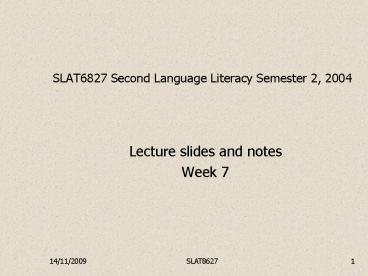SLAT6827 Second Language Literacy Semester 2, 2004 - PowerPoint PPT Presentation
1 / 26
Title:
SLAT6827 Second Language Literacy Semester 2, 2004
Description:
(from Winograd & Hare, 1988, in Carrell, 1998) 9/22/09. SLAT8627. 23 ... Carrell, P. (1998). Can reading strategies be successfully taught? ... – PowerPoint PPT presentation
Number of Views:27
Avg rating:3.0/5.0
Title: SLAT6827 Second Language Literacy Semester 2, 2004
1
SLAT6827 Second Language Literacy Semester 2,
2004
- Lecture slides and notes
- Week 7
2
Aims of the lecture
- Distinguish between testing and teaching
reading. - Identify key principles underlying reading
instruction - Examine the role of strategies in reading
instruction.
3
Similarities between testing and teaching reading
- Both involve a student
- (1) being required to read a text or texts
- (2) And then responding to it
- the task should approximate real-life use as
much as possible
4
Differences between testing and teaching reading
- The main focus in testing is on reliability
- Teaching can/should take into account different
interpretations - Focus on lower level skills sometimes needed
5
How do you teach someone to read?
- Is reading skill different from language skill?
- Is instruction necessary?
- What do you teach? (i.e., what is reading
comprehension?)
6
Fluent reading requires
- the development of top-down and bottom-up
processes conjointly - a high degree of control over grammatical
structures - cohesion and coherence markers
- a large vocabulary
- automatic word and phrase recognition skills
- word recognition exercises
- phrase recognition
- rate-building
7
An interactive approach to second language reading
- Top-down processes - the use of background
knowledge, expectations and contexts - Bottom-up processes rapid and accurate
recognition of letter and words, lexical access,
automaticity in processing - Which one is the starting point?
- Which one is the controlling factor?
8
(No Transcript)
9
Reading instruction as strategy training
- Give a man a fish .......
- Strategy training attempts to develop the
learners general reading skills, rather than
focusing on just understanding a specific task.
10
Strategy versus skill
- A skill is cognitive ability which a reader is
able to use when interacting with text. It has
been automatised and operates largely
unconsciously. - A strategy is a conscious procedure carried out
by the reader in order to solve a problem.
11
- The use of the term strategy rather than
skill shifts the focus to actions that readers
actively select and control to achieve desired
goals or objectives strategies are skills
under construction Carrell, 1998
12
Cognitive and metacognitive strategies
- Cognitive strategies involve application of
processes directly involved in understanding the
text. - Metacognitive strategies involve an awareness of
ones own mental processes and an ability to
reflect on how one learns (pp 179)
13
Cognitive strategies.
- (Urquhart Weir, 1998)
- Tasks at the local and global level
- Purpose of reading determines choice of strategy
14
Cognitive strategies Local tasks
- Word recognition
- Automaticity
- Speed in reading
- Vocabulary acquisition
- Grammatical skills
- Cohesion
15
Cognitive strategiesglobal tasks
- Understanding explicitly stated main ideas
- Understanding implicitly stated main ideas
- inferring pragmatic meaning
- Understanding pragmatic meaning related to a text
16
Reading skills
- Skimming
- Search
- Scanning
- Extensive reading
17
Metacognitive strategies in L2 reading
- Reading strategies allow readers to elaborate,
organize and evaluate information derived from a
text. (Carrell, 1998, p4) - Learning to read gtgtgt Reading to learn
18
Strategic reading is a prime characteristic of
expert L2 readers (1)
- Hosenfeld (1977) study of U.S. high school FL
learners - Successful L2 reader
- gt Kept meaning of passage in mind while reading
- gt Read in broad phrases
- gt Skipped words unimportant to total phrase
meaning - gt Had positive self concept as reader
19
Strategic reading is a prime characteristic of
expert L2 readers (2)
- Hosenfelds (1977) unsuccessful L2 reader
- gt Lost meaning of sentences as soon as they
were decoded - gt Read in short phrases
- gt Seldom skipped words as unimportant
- Had negative self concept as reader
20
The importance of going beyond the text.
- Bocks (1986) study of English L1 and L2 readers
in university remedial course found that more
successful learners - gt integrated the various parts of the text
- gt recognised aspects of text structure
- gt used general knowledge, personal experiences
and associations - gt responded in an extensive as opposed to a
reflective mode
21
- Critical issue making reading strategy
instruction appropriately text and context
sensitive instead of a mindless teaching of lists
of strategies.
22
Steps in reading strategy instruction
- The teacher needs to explain
- what the strategy is
- why the strategy should be learned
- how to use the strategy
- when and where the strategy should be
used - how to evaluate use of the strategy
- (from Winograd Hare, 1988, in Carrell, 1998)
23
Can reading strategies be taught?
- Do strategies represent natural learning styles
or are they techniques to be taught? - Reading strategies arent instant recipes for
success but can help learners take control of
their learning.
24
References
- Carrell, P. (1998). Can reading strategies be
successfully taught? Australian Review of Applied
Linguistics 21, 1, 1-20. - Ramírez, A. G. (1995). Creating contexts for
second language acquisition. White Plains, NY
Longman Publishers.
25
Last slide SLAT6827 week7
26
Discussion points
- An interactive model would predict, for
example, that at earlier stages of development
the differences in reading in different languages
would be greater than at more advanced stages of
development. Eskey Grabe, 1988 - Why?































